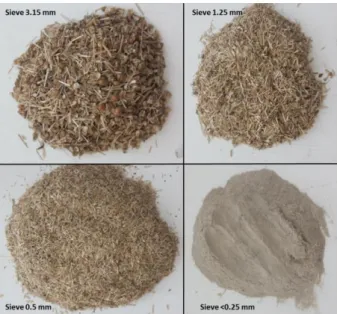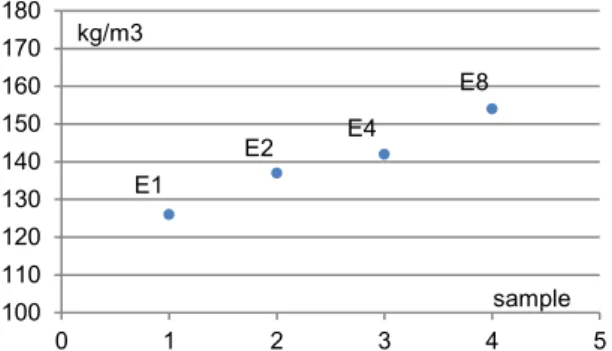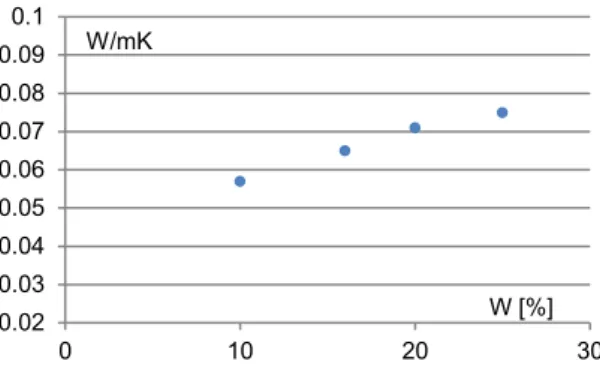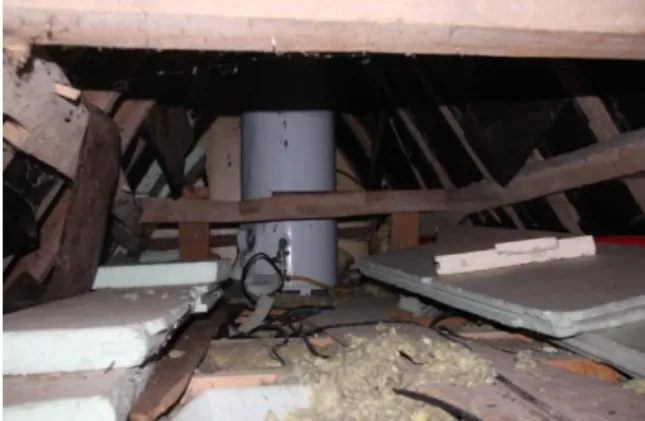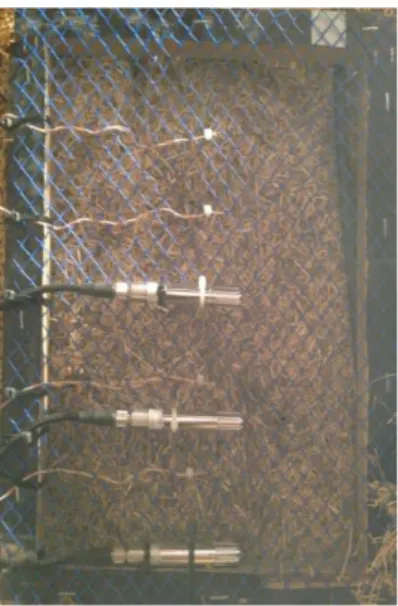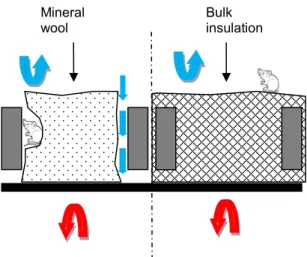EcoGRAFI
2nd International Conference on Bio-based Building Materials &
1st Conference on ECOlogical valorisation of GRAnular and FIbrous materials June 21th - 23th 2017 Clermont-Ferrand, France
MONITORING AND THERMAL CHARACTERIZATION OF FLAX SHIVES FOR
BUILDING THERMAL INSULATION
E. Antczak1*, M. Asli1, F. Brachelet1, F. Brue2, D. Defer1, A. Lucas3
1 Univ. Artois, EA 4515, Laboratoire de Génie Civil et géo-Environnement, Béthune, France 2 UC Lille, Yncréa HdF - HEI, Laboratoire de Génie Civil et géo-Environnement, Lille, France
3 cd2e, Base du 11/19, Loos en Gohelle, France
*Corresponding author; e-mail: emmanuel.antczak@univ-artois.fr
Abstract
This work involves the study of flax shives, natural product derived from the flax production. We want to valorize it as a local resource for thermal insulation of buildings, guaranteeing a low impact on the environment, especially that it doesn’t go through any transformations apart from the addition of a biological fire retardant. Flax shives arise from flax plant that is grown in Western Europe. From retting flax phase to scutching, flax fibers are separated from the stem. When grinding, the central stem is broken into small fragments called flax shives which represent about 50% of flax production. The developed research focuses on flax as additional fiber for cementitious materials such as manufacturing flax concrete blocks. The use of flax in the building sector concerns essentially the insulation. This solution mobilizes the short fiber flax, called tow. The insulation is usually available in soft rolls or semi-rigid panels of wool. Currently, the shives are used as bedding for animals or are integrated in the component mixture of particle board. The main scientific issues related to the study of heat and mass transfer is to determine the evolution of the thermal characteristics of the material and its durability.
For a first step, we propose a laboratory analysis of hygrothermal behavior of shives by conventional thermal methods for characterizing thermal conductivity and volumetric heat (flow meter methods), sorption curve is also determined. Then comes the experimental part that involves an independent house in which the old insulation of the attic (glass wool) was replaced by flax shives. We followed the hygrothermal behavior of this new insulation. This work takes place as a part of a project named "Citizen Researchers" of the “Hauts de France” region.
Keywords:
Flax shives, thermal insulation, monitoring, thermal conductivity, relative humidity.
1 INTRODUCTION
The circular economy approach is an alternative solution that is currently taking off in view of the global energy context [Biswas 2016] [Thomsen 2016] [Khadiran 2016]. The principle is to valorize the local natural resources and to use them within the framework of short circuits of distribution [Lasvaux 2016]. If one takes the example of the thermal insulation of buildings, traditionally France relies on industrial products based on mineral fibers and plastic foams, energy-intensive products in terms of manufacturing. Because of their fibrous nature and low density, straws from agricultural production have interesting characteristics for application in the field of building. They have been used for many centuries for the fabrication of building materials such as cob, in particular, or more recently in the form of manufactured concrete hemp blocks. In this study, we propose to use a bio-sourced product, derived from local agriculture, in its raw form. The energy cost to process this type of product is low, the problem of recycling does not arise.
The use of local resources limits the transport and the natural origin of products reduces the impact on health and environment. Moreover, in the “Hauts de France” region, the old housing stock is very important, in urban areas as well as in rural ones. The renovation of this housing is essential if the region wants to meet its objectives of reducing 60% of energy consumption and
dividing greenhouse gas emissions by 5 by 2050. The objective of the project (named “Flax Shives for Renovation”) is to develop an affordable insulation solution for the existing lofts in an area where bio-sourced material is located nearby. The geographical area targeted is the French maritime Flanders, which has been implementing local development strategies for many years to enhance the economy, agriculture, heritage, culture and environment. This area is located between the cities of Bailleul and Dunkerque in the Northern department, where the farming of flax is important and the traditional old housing is protected, its surface is about 1500 km². The material studied comes from flax, which remains a regional farming
which market relies mainly on textiles. The flax shives, "peel" of flax, account for 50% of the production and are used partly in the manufacture of wood panels and mulching. The aim of the project is to orient the flax shives to the thermal renovation of old buildings in their most basic form, bulk, within the framework of the necessary constructive constraints. An experimental building was identified in the territory and will be rehabilitated. It will be monitored to follow its thermal performance. This operation is also a part of self-construction, in other words, it aims to develop the building and construction knowledge of the population. This approach should make it possible to offer to a part of the population access to efficient, natural and low cost insulation. This project brings together associations (Yser Houck and cd2e), an university laboratory (LGCgE), an urban community (Pays des moulins de Flandre) and the company Solvay. The Yser Houck association aims to preserve the local architectural heritage and valorizes the traditional construction based on natural products. The Cd2e brings its expertise in the field of bio-based materials and their use in renovation. A partnership is planned with the company Solvay to study the behavior of this material against fire and insects. The scientific aspects, mainly those related to the hygrothermal performances of the material, are performed by the LGCgE. Natural fibrous materials are sensitive to the presence of water in liquid or vapor form, in terms of stability of thermal performance or durability. They are associated to ancient walls and to volumes more or less moist whether occupied or not. It is important to be able to know their behaviors in terms of implementation and their thermal performance compared to what is commonly used for building construction [Vololonirina 2014] [Lelievre 2014].
2 DEVELOPMENT OF THE MATERIAL 2.1 Staple material: flax shives
This project focus on flax shives, which are a co-product of flax co-production. Flax farming is an old activity whose oldest mark dates to 36 000 years ago. Production essentially concerns Western Europe, in particular countries around North Sea, the Channel and Baltic Sea, because flax plant doesn’t like heat and deficiency of water. All parts of flax plant are kept for different uses such as seed making oil or dust powder to be included in compost. The main industry which uses flax is textile production. Paper mill as manufacture of eco-materials is also a “user” of flax. Actually France is recognized for its farming of flax, which represents 2/3 of the worldwide production. French farming of flax takes place in different regions such as Normandie and the Hauts de France regions. Farming of flax is mainly intended for textile fibers, named tow, got after retting and scutching operations. Retting is equivalent to a desiccation time of flax stem after uprooting. Scutching is a mechanical operation which enables to obtain fiber of stem just as seed and peel. During this operation, peel of flax is crushed and it gives out a lot of dust. At the end of scutching, crushed peel of flax named flax shives, are kept bulk and then represented as a co-product of flax and not a waste [Kozakowski 2012].
Flax shives present an alveolar structure and a good absorbent power because of its density equal to 120 kg/m3 when there is no compaction. Moreover it has a good calorific power equal of the one of wood.
Scientific studies about hygrothermal properties of flax shives are not so much developed because it was not considered as a noble product. Actually flax shives are mainly used for animal litter or panel of wood. However, this co-product of flax would be interesting for other applications. The gross composition of this material is very varied: straw length ranging from a few mm to about 20 mm, seed hulls, residual dust ... as show it Fig. 1.
Fig. 1: composition of flax shives.
One aim of this project is to characterize hygrothermal properties of flax shives used without major transformation, as thermal insulation of building. However a processing had to be made on flax shives in order to be in compliance with regulation of the building field, as described in the following paragraph. 2.2 Processing of flax shives
Although in this study flax shives are used in a state closest to their initial form, a treatment have to be made in order to accentuate the fire-resistant property and stop the appearance of insects. In this way, the company Solvay has developed a product to reinforce the durability of flax shives. This product, named Shives-Protect, is a mineral powder mainly composed of sodium carbonate and bicarbonate (> 60% of the composition), which exist naturally. Moreover the mineral powder is classified non dangerous product according to the regulation CLP 1272/2008. Thus, the addition of this product in flax shives protects its natural characteristic. Furthermore, in order to combine flax shives with mineral powder, a mix had to be made. To do this, flax shives had been mixed with the product of Solvay and water in a blender with the following proportions in order to obtain a homogenous mix: flax shives (10kg), Shives Protect (2.2 kg) and water (3 liters). The water allows to fix the powder on the straw. Treatment modifies the density of flax shives, the increase is from 20% to 25%. The particle diameter of mineral powder is less than 0.25 mm, therefore the proportion of dust increases in the mixture. This co-product is used in the most basic form that comes from the extraction of fibers used for textile, this explain its very heterogeneous composition.
2.3 Thermophysical characterization
In order to better understand the product and to be able to study its hygrothermal behavior, its main thermophysical characteristics are evaluated in the
laboratory. Since the product is of natural origin and has very little processing, it is necessary to know the influence of the settlement and the humidity on its performance, because it can be subjected to seasonal cycles and any mechanical stresses.
Density as a function of settlement
The protocol consists of weighing a cylindrical test piece of 16x32, traditionally used for tests on concrete, filled with more or less packed flax shives, in the laboratory environment at a relative humidity of 50%. These dimensions are representative of the thickness of the material used in situ. For the lowest density (E1), the material is poured freely into the sample holder. And then, in order to increase its density, it is placed in form of compacted layers (E2, E4, E8, the number indicated specifies how many layers are produced). Each layer is compacted by dropping a mass onto its surface. The measurement is performed 3 times, average of the three tests is calculated. The results obtained are presented Fig. 2.
Fig. 2: Densities obtained for flax shives.
The densities obtained are quite high compared to those found for traditional insulation. They are positioned between 126 kg/m3 and 154 kg/m3, with an average value of 140 kg/m3, which could be a representative value of the naturally packed material over time. Compared to existing products for this type of insulation, bulk mineral wools have a density between 20 kg/m3 and 80 kg/m3, the cellulose wadding is blown to a density of 50 kg/m3. The high density of flax shives is due to the presence of fines (dust, adjuvant), the nature of the fibers, their small size (about 5 mm to 20 mm long with a diameter of about 1 mm) and to their shape which allows an optimized arrangement which has the advantage to limit the settlement in time.
Thermal conductivity
Thermal characterization techniques are based on the study of the response on a thermal loading of the system. Thermal characteristics are measured in steady state, the guarded hot plate and heat flow meter methods according to the standard [NF EN 12664 2001] is developed in the laboratory [Sassine 2017], Fig.3 shows a schematic of the principle. The guarded hot plate aims to measure thermal conductivity and specific heat of the tested material. The advantage of this method is the simplicity to perform and the results accuracy. The measurement of the insulating materials is relatively fast (about 1 hour for an insulator), which limits the risks of thermomigration, problems of contact resistance are also restricted because of the opened structure of the material surface. The experimental setup consists on maintaining a temperature difference (ΔT) between two
parallel flat plates, a sample with known thickness (e) is positioned between them, and the sample’s area is over (15 cm x 15 cm), which is the area of flux sensor, in order to prevent border effect.
Fig. 3: Thermal conductivity measurement.
Thermal Resistance R [m².K/W] is calculated as follow:
T/
R (1)
Where Ф (W.m-²) is the average of the measured heat flux. The thermal resistance is obtained after reaching the steady state, the thermal conductivity is deduced from the measurement of the thickness (e). Samples were stored for several weeks at temperature and relative humidity of the laboratory (=20°C and RH=50%), their mean temperature during the test is 20°C.
Fig. 4: Thermal conductivity of flax shives versus density.
We observe that an increase of the thermal conductivity is correlated with the density, which is logical as the volume of air, whose insulation capacity is high, is reduced within the material. It is between 0.057 W.m-1K-1 and 0.064 W.m-1K-1, it is a fairly high value compared to a traditional insulation, around 0.04 W.m-1K-1 on average, but which can be compensated by a thick material used, a sufficient resistance thus is achieved. Measurements have also been made for moisture. Indeed, under in situ conditions of use, the relative humidity of the environment varies greatly according to the seasons in the volume of the attic. It is important to know the impact on thermal performances.
Fig. 5 shows the evolution of the thermal conductivity as a function of the mass water content W (10%, 16%, 20%, 25%) which correspond to a relative humidity ranging from 50% to 95% of the environment and a temperature of 23°C. The choice of this temperature is related to the conditions of sorption tests which are carried out at the same time and which require a strict protocol [NF EN ISO 12571 2013]. 100 110 120 130 140 150 160 170 180 0 1 2 3 4 5 kg/m3 sample E1 E2 E8 E4 0.02 0.03 0.04 0.05 0.06 0.07 0.08 0.09 0.1 110 130 150 170 W/mK kg/m3
Fig. 5: Thermal conductivity versus humidity.
These tests comply stabilization stages that can last for a very long time. To get closer to winter conditions, it will be necessary to complete this work by a test at 10°C (mean temperature of flax shives in winter). The measurements were made for a density at RH = 50% of 130 kg/m3, this corresponds to the material during its implementation and the first months of use. The thermal conductivity varies from 0.057 W.m-1.K-1 to 0.075 W.m-1.K-1, an increase of about 30%. The thermal resistances obtained vary from 4 m².K.W-1 to 5.25 m².K.W-1 which corresponds to a thickness of mineral wool of 20 cm, perfectly laid.
Specific heat
Likewise for the specific heat, it is evaluated with the same device, only the thermal loads imposed change. First the previous system (sample and fluxmeters) is submitted to a constant temperature until reaching the steady-state, then we change towards another constant temperature and wait for the steady-state again. We assume that the sample goes from initial time tini (at temperature Tini) to final time tfin. (at temperature Tfin), between these instances the sample stores an amount of energy Q (J.m-2). In this case the heat capacity C (J.K-1.m-2) is calculated as follows:
tfin tini dt . Q (2) T / Q C (3)Where ΔT = Tfin - Tini
The specific heat c [J.K-1.kg-1] is calculated:
.A.e
/ C
c (4)
Where ρ [kg.m-3] and e [m] are the material density and thickness respectively, concerning the heat flux density measured we assume that A = 1 m².
Fig.6: Specific heat of flax shives.
The values obtained are in the range usually observed for insulating materials, between 1200 J.kg-1K-1 and
1600 J.kg-1K-1. The interesting point is that the flax shives have a density higher than those of the traditional insulation, which gives them very interesting properties in case of heat storage
Sorption curve
The use of a natural material requires knowing its capacity to regulate the ambient humidity. The measurement protocol consists of placing the sample in a climate chamber controlled at constant temperature (23°C) and imposing relative humidity ranges from 0% to 95% (depending on the performance of the enclosure) [NF EN ISO 12571 2013]. This measure also makes it possible to relate relative humidity levels ambient measurements in situ to mass water contents of the materials in order to detect risks of development of microorganisms or molds.
Fig.7: Sorption curve of flax shives.
The curve Fig. 7 represents the sorption which does not reveal a true level between RH=10% and RH=60% as can be observed usually. This may be due to the natural presence of fines and sodium bicarbonate.
3 IMPLEMENTATION, INSTRUMENTATION 3.1 Aims of “Flax Shives for Renovation” project The first aim of this project is the development of a solution of thermal insulation for old housing with the use of a bio-based materials. Moreover, this solution have to be affordable for the population. Thus, partners of project chose to promote local industry of natural resources with the use of expertise of the area. The studied area is the French maritime Flanders, included between both cities Dunkerque and Bailleul, in which we can easily find flax shives, co product of flax farming. This project assembles different partners who bring their expertise explained in the first paragraph and have several aims:
• Yser Houck association supports culture and know-how of the maritime Flanders with formations and eco-constructions. Yser Houck works with the “Pays des moulins de Flandre” association, which is in contact with different actors of this area. Their shared aim for this projet is the diffusion of new technique of rehabilitation of old housing in agreement with the History of the maritime Flanders. • Cd2e association is an expert of
eco-construction and in this project hope for accompanying the professionals using new techniques and regulations for this new use of flax shives. 0.02 0.03 0.04 0.05 0.06 0.07 0.08 0.09 0.1 0 10 20 30 W/mK W [%] 1200 1250 1300 1350 1400 1450 1500 1550 1600 110 130 150 170 kg/m3 J/kg K 0 5 10 15 20 25 30 0 20 40 60 80 100 water content [%] Relative humidity [%]
• The team “Habitat” of the laboratory LGCgE will study the scientific aspects of the hygrothermal behavior of flax shives compared to other bio-based materials and other projects in different areas.
• The company Solvay takes a part in this project as a service provider but also cares about this kind of studies for new use of materials.
All partners of the project are attached to use flax shives in bulk form to insure the use of a non-transformed products and reduce energy consumption. Flax shives are being submit to a small treatment described in the previous paragraph to reinforce durability. Furthermore one part of the project is the characterization of hygrothermal behavior of flax shives with tests made in laboratory on flax shives with or without Shives-protec product. Once each partner’s objective was clearly defined, an experimentation in an old housing was set up.
3.2 Experimentation
The experimentation set up concerns a typical housing of the French maritime Flanders (Fig.8). The materials used are traditionally brick and cob, the construction dates go back to 1610. The house is a single level construction. The roof has a steep slope above 60 ° to allow the flow of light rain. The lengths of the facades are important in comparison to the widths of the sprockets in order to favor the positioning of the openings on the south side. This explains the narrowness of the attic where the material will be used. The particularity of the construction resides in its cylindrical form chimney, typical of the flandrian dwellings during the XVIIth century. The aim of this
experimentation is to quantify the hygrothermal properties of flax shives used in its bulk form as thermal insulation. This house is occupied during the experimentation in order to have real conditions of rehabilitation and to get the perception of inhabitants. Hygrothermal sensors, described in the following paragraph, were set up in the housing before the rehabilitation of a part of the house. Sensors record evolution of temperature and relative humidity before, during and after the implementation of flax shives as thermal insulation. However the use in bulk form of flax shives needs to find a non-occupied room for the thermal rehabilitation, that’s why the experimentation is made in the attic of the house, which is not equipped and is a part of the loft of the house.
Fig. 8: Instrumented house.
The attic is 75 m2 and presents recent roof and vapor barrier. It is easily reachable with a trapdoor overlooking rooms and bathroom, which are the other equipped part of loft of the house.
Before thermal rehabilitation, the attic was insulated with glass wool since several years. Thus the glass wool was compacted with time and has given dust and microfibers in the attic. Moreover, rodents were detected by its dropping, which suggests that they have “eaten” the glass wool. Fig. 9 presents the attic before the thermal rehabilitation.
Fig. 9: Attic before thermal rehabilitation (glass wool insulation).
The implementation of flax shives as thermal insulation was made during one day by steps described below:
• The glass wool was removed in the attic and all electrical device were protected
• A flexible membrane was put on floor • At the same time, the mix with mineral
powder and flax shive is made (paragraph 2.2)
• After mixing, treated flax shives are packed in order to be taken in the house
• Flax shives were put in bulk form on the floor with a layer of 30 cm
Fig. 10 presents the attic after the thermal rehabilitation. Even if the products used are natural, workers are advised to wear a respirator and goggles to protect themselves from dust. Electrical boxes and openings in the ceiling (lightings) were protected to prevent the entrance of flax shives.
Fig. 10: Attic after thermal rehabilitation with flax shives.
3.3 Instrumentation set up and monitoring
The installation of an instrumentation aims to monitor the hygrothermal behavior of the material, depending on the in situ conditions and according to the seasons. It must be ensured that the thermal performances are sufficient and that the regulation of the humidity is effective. The sensors used are thermo-hygrometers
(HMP 110 Vaisala and recorders Easylog EL-USB 2+) and thermocouples (Fig. 11). The measurements of temperature and of hygrometry are carried out in the ambient volumes and in the mass of the sample
Fig. 11: Humidity and temperature probes.
A support (Fig. 12), vertically positioned, consisting of wooden frame and PVC mesh allows the thermocouples and thermohygrometers to be placed at equal distances within the thickness of the material. The use of a support with large mesh makes it possible not to disturb the arrangement of the flax shives nor transfers of moisture and heat.
Fig. 12: Positioning of probes on the support.
Measurements of ambient humidity in the attic and in the inhabited part of the house are also carried out, they make it possible to demonstrate the influence of the behavior of the flax shives on the ambient volumes. The distribution of the sensors is done according to the following sketch:
Fig. 13: Positioning of probes in the house.
The sensors are connected to a data reception unit which carries out a data survey every 20 min, during the project period, i.e. around 18 months.
4 IN SITU MEASUREMENT
We will first analyze the temperature and humidity data from February to November 2016. To facilitate readability, we selected the months of February and August, representative of winter and summer periods. These are the most constraining periods in terms of temperature and humidity where extreme values are measured.
4.1 Winter 2016
Fig. 14: Relative humidity measurements.
The curves shown in the Fig. 14 correspond, respectively from top to bottom, to the attic, to the three measurement levels in the flax shives and to the heated interior volume of the house, from February 1th to March 3th. It is known that hot air can contain more moisture than cold air, so it is logical to find the heated volume between RH=50% and RH=60%. The flax shives in contact with the ceiling (plasterboard) seem to be influenced by the volume heated, where humidity is linked to human activity. Roof tile vents ensure air renewal in the attic, influenced by the outside relative humidity. The curves hihglight the hygric inertia of flax shives, due to their sortion/desorption capacities. The RH variations of the air, inside and outside, are damped in the material where vapor transfer are much slower and linked to sorption characteristic of fiber. The relatively high humidity of the flax shives compared to that of the attic means that the relative humidity remains stable despite the variations in the atmosphere of the attic. The values are also influenced by the introduction of wet flax shives at the beginning of measurements.
The curves on Fig. 15 show, in decreasing order of temperature, the temperatures of the inhabited volume, then the three sensors placed in the flax shives and at the lowest temperatures, the ambient temperature of the attic. The flax shives fulfill their role well as an average temperature of 10 ° C is observed between the lowest and the highest temperatures, the amplitudes are well attenuated by the thermal insulation.
It is possible to estimate the phase delay induced by the thermal insulation by measuring the offset between a peak temperature observed in the attic and its distribution in the thickness of the material (Fig. 16), in particular at the level of the sensor close to the ceiling. The measured phase delay is 7H30.
30 40 50 60 70 80 90 100 0 2 4 6 8 10 12 14 16 18 20 22 24 26 28 30 RH [%] days Wooden beam Flax shives T(°C) and RH(%) of the attic
T(°C) and RH(%) of flax shives
T(°C) and RH(%) of the inhabited volume Ceiling
Fig. 15: Temperature measurements.
Fig. 16: Phase delay.
4.2 Summer 2016
Temperatures are higher in summer, hence relative humidity levels are lower at equal amount of moisture in the attic (Fig.17).
Fig. 17: Relative humidity measurements.
As a result, the curves become narrower, the average hygrometry of the attic is lower than that of the inhabited volume where human activity produces steam. The relative humidity levels in the flax shives are homogeneous and are around a value of 60%, which is very interesting compared to the use of the wet material a few months previously.
There are large variations in the amplitudes of the ambient temperature of the attic (up to 21°C over 24H), which is linked to the summer climatic conditions and the low ventilation of the volume. Amplitudes are well damped since the highest amplitude variations over 24H does not exceed 3 ° C in the lower part of the flax shives (Fig. 18). The impact on the interior volume is reduced. The characteristics of the materials evolving, the phase delay in summer is 7H (Fig. 19).
Fig. 18: Temperature measurements.
Fig. 19: phase delay.
The measurements make it possible to obtain some information on the hygrothermal behavior of the flax shives. The phase delay and the damping of the stress induced by the product is advantageous when compared with lighter insulators in particular. The relative humidity data also reveal a homogeneous behavior over the measurement period despite the use of the material in the wet state. Data from winter 2017 will be needed to further improve this analysis. For the problems of air permeability of the ceiling, the bulk insulation has the advantage of being distributed by gravity around the wooden framework systems (beams, joists, structural elements…) which makes it possible to improve the air tightness of the constructive system. Due to their higher initial density, flax shives are less subjected to compaction than low density mineral wools (Fig. 21). In fact the granulometric structure of flax shives does not allow rodents to make nest since the galleries collapse under the weight of the material (Fig. 20) so they are less attractive oppositely to what we can suppose (natural straw, residual seeds ...). The compaction and the arrangement of the flax shives are done in favor of the air tightness. Visually, after one year of exploitation, we observed only one rodent (a dormouse) that made a nest with remnants of mineral wool coming from an old water supply. This shows that it was not possible for it to nest in the flax shives. Despite its natural origin, but thanks to its density and its mechanical instability, the flax shives do not favor the presence of pests. It can also be observed that, unlike the used mineral wools which release large quantities of microfibers into the atmosphere of the attic, once installed, the flax shives do not cause the presence of suspended dust.
0 5 10 15 20 0 2 4 6 8 10 12 14 16 18 20 22 24 26 28 30 T(°C) Days 8 9 10 11 12 13 14 15 16 20.00 20.20 20.40 20.60 20.80 21.00 T(°C) Days 30 40 50 60 70 80 90 100 178 182 186 190 194 198 202 206 210 Days RH [%] 10 15 20 25 30 35 40 180 190 200 210 T [°C] Days 20 25 30 35 40 45 202.0 202.5 203.0 203.5 204.0 T [°C] Days
Fig. 20: Mineral wool versus flax shives.
Fig. 21: Implementation homogeneity
5 CONCLUSION
The project "Researchers-Citizens" aims at bringing together university laboratories and the regional population in the framework of a participatory action. Our goal is to valorize a cheap and local material to serve efficiently the people of the territory for the renovation of their houses. The flax shives were used in their raw form, harvested on the spot and treated with a fire retardant used in organic food. The thermal performances determined in the laboratory are encouraging, knowing that for this type of material, the bulk form does not limit the thickness used, it is therefore always possible to obtain an interesting thermal resistance. The material is highlighted thanks to its high density, which favors its inertia and its use in bulk which makes it possible to obtain a layer more airtight than a product in the form of wool, and less sensitive to settlement.
Hygrometric readings show advantageous reaction to fluctuations in relative humidity whatever the season is. The humidity levels found within the material do not indicate any risk of mold growth. The natural and farming origin of the product do not favor the presence of rodents, as these can not nest because of the impossibility of creating galleries. Flax shives clearly show hygrothermal qualities in the context of a use as
bulk insulation for the renovation of traditional buildings. Their low energy cost to their production is obvious, since it is a by-product derived directly from farming.
6 ACKNOWLEDGMENTS
The “Hauts de France” region is funding the project within the framework of the "Citizen Researchers" call projects.
7 REFERENCES
[Biswas 2016] Biswas K., Shrestha S.S., Bhandari M.S., Desjarlais A.O., Insulation materials for commercial buildings in North America: An assessment of lifetime energy and environmental impacts, Energy Build., vol. 112, pp. 256–269, Jan. 2016
[Khadiran 2016] Khadiran T., M. Z. Hussein M.Z., Z. Zainal Z. , R. Rusli R., Advanced energy storage materials for building applications and their thermal performance characterization: A review, Renew. Sustain. Energy Rev., vol. 57, pp. 916–928, May 2016 [Kozakowski 2012] Kozasowski R.M, Mackiewicz-Talarczyk M.,. Allam A.M, Handbook of Natural Fibres, Pages 56-113, 2012.
[Lasvaux 2016] Lasvaux S, Achim F., Garat P., Peuportier B., Chevalier J., Habert G., Correlations in Life Cycle Impact Assessment methods (LCIA) and indicators for construction materials: What matters?, Ecol. Indic., vol. 67, pp. 174–182, Aug. 2016
[Lelievre 2014] Lelievre D., Colinart T., Glouannec P., Hygrothermal behavior of bio-based building materials including hysteresis effects: Experimental and numerical analyses, Energy Build., vol. 84, pp. 617– 627, Dec. 2014
[NF EN 12664 2001] NF EN 12664, “Thermal performance of building materials and products. Determination of thermal resistance by means of guarded hot plate and heat flow meter methods. Dry and moist products of medium and low thermal resistance,” pp. 75–225, 2001.
[NF EN ISO 12571 2013] NF EN ISO 12571 Hygrothermal performance of building materials and products- Determination of hygroscopic sorption properties, 2013
[Sassine 2017] Sassine E., Younsi Z., Cherif Y., Antczak E., Frequency domain regression method to predict thermal behavior of brick wall of existing buildings, Applied Thermal Engineering, Volume 114, Pages 24-35, March 2017.
[Thomsen 2016] Thomsen K. E., Energy consumption and indoor climate in a residential building before and after comprehensive energy retrofitting, Energy Build., vol. 123, pp. 8–16, Jul. 2016
[Vololonirina 2014] Vololonirina O., Coutand M., Perrin B., Characterization of hygrothermal properties of wood-based products – Impact of moisture content and temperature, Constr. Build. Mater., vol. 63, pp. 223– 233, Jul. 2014
Mineral wool
Bulk insulation
